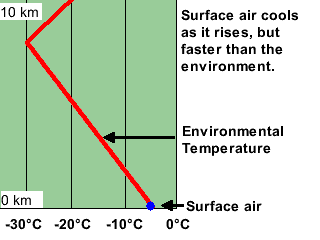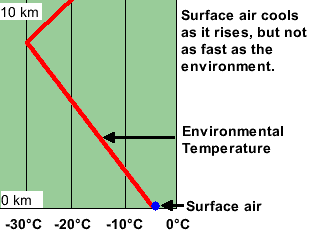
|
Storms developing in one environment can be different in character than those developing in another. Modelers can alter the stability of the atmosphere in which they simulate storms by changing the vertical distribution of temperature and moisture.
Thunderstorms develop when surface and low level air is allowed to rise without restriction into the upper troposphere. If air rises in an environment without restriction, the environment is said to be unstable. This means that stability is simply the resistance the atmosphere imposes on rising (or sinking) air.
Stable Environments
Air temperature in the atmosphere generally decreases with height.
However, when low level air rises, it cools at a rate that is often
different from the air's surrounding environment.
If, as it rises, the low level air becomes colder than its environment,
it would be more dense than the environment and fall back toward its
original level. This is a stable environment.
| The only way air can rise in a stable environment is for a mechanical force such as a front to lift it. |  |
If, however, the rising air cools at a slower rate than the surrounding atmosphere, it will be warmer (and less dense) than its surroundings. Here, the rising air would continue rise.

| The larger the temperature difference between the rising air and the environment, the more buoyant the rising air is. The more buoyant the air is, the faster it can rise, and the more severe the thunderstorm can become. |
Sometimes, the environment is stable near the ground and must be forced to rise into unstable air by a front or other mechanism.
|
